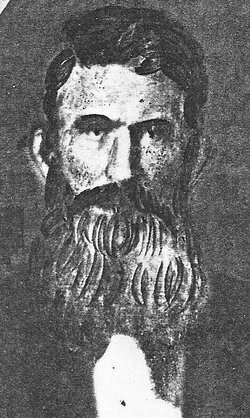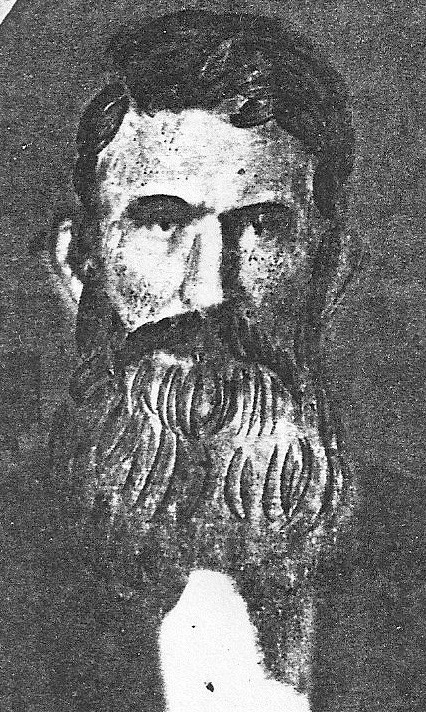By the summer of 1852, Thomas Allen and family are documented in Kanesville, Iowa, by now renamed Council Bluffs. Correspondence between Thomas’s brother-in-law and other family members show evidence that those living in Council Bluffs were well aware of the proposed opening of Nebraska Territory for settlement.
Seeing the potential for a city on the shores across the Missouri River from Council Bluffs, William D. Brown began operating The Lone Tree Ferry, later known as the Council Bluffs and Nebraska Ferry Company, the purpose of which was to promote westward expansion across the river. The ferry company became an instrumental force in transporting settlers across the Missouri River into Nebraska Territory.
In November of 1853, a preliminary scout and staking of claims of the new city of Omaha took place, an effort organized by Alfred D. Jones. Thomas and his brother, William Allen, were subcontractors for the Council Bluffs and Nebraska Ferry Company when Jones proposed to them the notion of staking a claim on the Nebraska side of the river. They borrowed a small boat, obtained provisions from the Allen household, and set forth on the dangerous undertaking. The frail, leaky craft was launched into the waters of the Missouri River at Council Bluffs with Thomas Allen as oarsman, Bill Allen to bail out the water, and Jones as helmsman. The three staked a claim for the Omaha Townsite and Ferry Company and began a trading house for Tootle & Jackson of Kanesville.
Shortly after January 1, 1854, when Stephen A. Douglas introduced the bill that would divide the land west of the Missouri River into two new territories, Thomas Allen erected the first house in what would become the city of Omaha. It was built of round logs, and stood on the corner of Jackson and Twelfth streets. The building was named the "St. Nicholas" and its purpose was to serve as a claim clubhouse and the general headquarters for the promoters of the city in anticipation of the impending settlement.
Early in the year 1854, and shortly after the structure was completed, Thomas brought his wife and children from Council Bluffs. They lived for several months in the claim house he had built. His stepdaughter, Rhoda, thus became the first white girl to live in the city of Omaha. Soon after a Fourth of July celebration of the event, Thomas Allen and his family moved from the St. Nicholas house and almost immediately thereafter, another family, presumably William Snowden of Kanesville, occupied it. The Snowdens have long been proclaimed the first residents of the city of Omaha, and Rachel Snowden the first white girl to live there. However, Rhoda Craig, stepdaughter of Thomas, maintained throughout her life that she was the first white girl to live in the new city and that the Snowdens came as her family left for Fort Calhoun, Nebraska. The distinction must be made, however, that the Allens left Omaha for Fort Calhoun, whereas the Snowdens remained residents of the new city of Omaha.
So Thomas J. Allen became the trailblazer for the family and paved the way for the migration of his brothers and their families to eastern Nebraska. Thomas and his family came to Fort Calhoun, Nebraska, at a time when there were fewer than five families living there.
In mid 1854, Thomas settled on 160 acres on the south edge the fledgling town of Fort Calhoun, part of a bounty land claim he purchased. About the same time, he was appointed the first Territorial Sheriff of Washington County, and in August 1856, he was designated Captain of the 5th Company of the Fort Calhoun Rangers.
Bank failures and the lure of gold took many men from Washington County to Colorado. Rumors of gold strikes on several small creeks in Nebraska Territory (near present-day Denver) touched off the Pike's Peak gold rush, and according to Thomas’s granddaughter, he was among the men who mined near “Pike’s Peak”, the most notable landmark in the area.
Thomas bought land in Huerfano County, Colorado, about 1861, at a time when the U.S. government was reappropriating original Spanish owned lands that were traded for other less valuable lands in Colorado. Thomas, Harriett and their four children, John, Gilbert, Harriett and Charles, settled in the southeast corner of the state probably in what is now Las Animas County—near Trinidad. Thomas’s stepdaughter, Rhoda, was married to Allen Craig by this time and remained in Fort Calhoun.
Shortly after settling in Colorado, their oldest son, John, was killed when a horse fell on him. Young Harriett married and moved near Weatherford, Parker County, Texas. According to information told by one of Thomas’s granddaughters, in January of 1868, Thomas, Harriett, and their sons, Charles and Gilbert, left Colorado for Texas for a visit. The family contracted typhoid fever and the parents died. They were buried on the banks of the Brazos or Trinity River (family legend is not clear on this point) in a camp they had made. Thomas wrote a will when he realized death was near. He left the wagon and team to his sons and directed Gilbert take young Charles, then just nine years old, back to his sister, Rhoda Craig, in Washington County, Nebraska, to receive an education. Gilbert returned to Texas.
Citation: Vinton, Merri Allen, Hillbillies & Hexsigns, "A Study of the Ancestors and Descendants of William Henry Allen & Ruth Emily Bottorff, of Washington County, Nebraska", 2008.
By the summer of 1852, Thomas Allen and family are documented in Kanesville, Iowa, by now renamed Council Bluffs. Correspondence between Thomas’s brother-in-law and other family members show evidence that those living in Council Bluffs were well aware of the proposed opening of Nebraska Territory for settlement.
Seeing the potential for a city on the shores across the Missouri River from Council Bluffs, William D. Brown began operating The Lone Tree Ferry, later known as the Council Bluffs and Nebraska Ferry Company, the purpose of which was to promote westward expansion across the river. The ferry company became an instrumental force in transporting settlers across the Missouri River into Nebraska Territory.
In November of 1853, a preliminary scout and staking of claims of the new city of Omaha took place, an effort organized by Alfred D. Jones. Thomas and his brother, William Allen, were subcontractors for the Council Bluffs and Nebraska Ferry Company when Jones proposed to them the notion of staking a claim on the Nebraska side of the river. They borrowed a small boat, obtained provisions from the Allen household, and set forth on the dangerous undertaking. The frail, leaky craft was launched into the waters of the Missouri River at Council Bluffs with Thomas Allen as oarsman, Bill Allen to bail out the water, and Jones as helmsman. The three staked a claim for the Omaha Townsite and Ferry Company and began a trading house for Tootle & Jackson of Kanesville.
Shortly after January 1, 1854, when Stephen A. Douglas introduced the bill that would divide the land west of the Missouri River into two new territories, Thomas Allen erected the first house in what would become the city of Omaha. It was built of round logs, and stood on the corner of Jackson and Twelfth streets. The building was named the "St. Nicholas" and its purpose was to serve as a claim clubhouse and the general headquarters for the promoters of the city in anticipation of the impending settlement.
Early in the year 1854, and shortly after the structure was completed, Thomas brought his wife and children from Council Bluffs. They lived for several months in the claim house he had built. His stepdaughter, Rhoda, thus became the first white girl to live in the city of Omaha. Soon after a Fourth of July celebration of the event, Thomas Allen and his family moved from the St. Nicholas house and almost immediately thereafter, another family, presumably William Snowden of Kanesville, occupied it. The Snowdens have long been proclaimed the first residents of the city of Omaha, and Rachel Snowden the first white girl to live there. However, Rhoda Craig, stepdaughter of Thomas, maintained throughout her life that she was the first white girl to live in the new city and that the Snowdens came as her family left for Fort Calhoun, Nebraska. The distinction must be made, however, that the Allens left Omaha for Fort Calhoun, whereas the Snowdens remained residents of the new city of Omaha.
So Thomas J. Allen became the trailblazer for the family and paved the way for the migration of his brothers and their families to eastern Nebraska. Thomas and his family came to Fort Calhoun, Nebraska, at a time when there were fewer than five families living there.
In mid 1854, Thomas settled on 160 acres on the south edge the fledgling town of Fort Calhoun, part of a bounty land claim he purchased. About the same time, he was appointed the first Territorial Sheriff of Washington County, and in August 1856, he was designated Captain of the 5th Company of the Fort Calhoun Rangers.
Bank failures and the lure of gold took many men from Washington County to Colorado. Rumors of gold strikes on several small creeks in Nebraska Territory (near present-day Denver) touched off the Pike's Peak gold rush, and according to Thomas’s granddaughter, he was among the men who mined near “Pike’s Peak”, the most notable landmark in the area.
Thomas bought land in Huerfano County, Colorado, about 1861, at a time when the U.S. government was reappropriating original Spanish owned lands that were traded for other less valuable lands in Colorado. Thomas, Harriett and their four children, John, Gilbert, Harriett and Charles, settled in the southeast corner of the state probably in what is now Las Animas County—near Trinidad. Thomas’s stepdaughter, Rhoda, was married to Allen Craig by this time and remained in Fort Calhoun.
Shortly after settling in Colorado, their oldest son, John, was killed when a horse fell on him. Young Harriett married and moved near Weatherford, Parker County, Texas. According to information told by one of Thomas’s granddaughters, in January of 1868, Thomas, Harriett, and their sons, Charles and Gilbert, left Colorado for Texas for a visit. The family contracted typhoid fever and the parents died. They were buried on the banks of the Brazos or Trinity River (family legend is not clear on this point) in a camp they had made. Thomas wrote a will when he realized death was near. He left the wagon and team to his sons and directed Gilbert take young Charles, then just nine years old, back to his sister, Rhoda Craig, in Washington County, Nebraska, to receive an education. Gilbert returned to Texas.
Citation: Vinton, Merri Allen, Hillbillies & Hexsigns, "A Study of the Ancestors and Descendants of William Henry Allen & Ruth Emily Bottorff, of Washington County, Nebraska", 2008.
Family Members
Advertisement
Records on Ancestry
Sponsored by Ancestry
Advertisement











